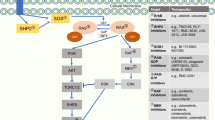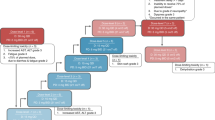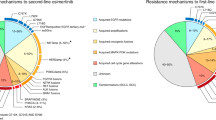Abstract
Background:
Selumetinib (AZD6244, ARRY-142886)+docetaxel increases median overall survival (OS) and significantly improves progression-free survival (PFS) and objective response rate (ORR) compared with docetaxel alone in patients with KRAS mutant, stage IIIB/IV non-small-cell lung cancer (NSCLC; NCT00890825).
Methods:
Retrospective analysis of OS, PFS, ORR and change in tumour size at week 6 for different sub-populations of KRAS codon mutations.
Results:
In patients receiving selumetinib+docetaxel and harbouring KRAS G12C or G12V mutations there were trends towards greater improvement in OS, PFS and ORR compared with other KRAS mutations.
Conclusion:
Different KRAS mutations in NSCLC may influence selumetinib/docetaxel sensitivity.
Similar content being viewed by others
Main
In non-small-cell lung cancer (NSCLC), KRAS is the most frequently mutated oncogene, accounting for 26% and 11% of adenocarcinoma tumours in Western and Asian patients, respectively (Dearden et al, 2013). Although some studies have shown KRAS mutations in NSCLC are associated with poor prognosis, including a meta-analysis of 28 studies (Mascaux et al, 2005; Johnson et al, 2013), conflicting results from other studies (recently reviewed in Martin et al, 2013) mean the prognostic impact of KRAS mutations in NSCLC remains unclear. Recently, with a number of agents in clinical development targeting KRAS mutant NSCLC, such as MEK inhibitors (Martin et al, 2013), it is important to discern the prognostic and predictive role of KRAS mutations.
In the phase II Biomarker-integrated Approaches of Targeted Therapy for Lung Cancer Elimination study (BATTLE; Kim et al, 2011), median progression-free survival (PFS) for patients with KRAS G12C or G12V mutations (1.84 months) was significantly shorter (P=0.046) compared with all other KRAS mutations (3.35 months) or wild-type KRAS (1.95 months; Ihle et al, 2012). In vitro analysis of cell lines carrying KRAS G12C or G12V mutations showed significantly decreased levels of phosphorylated AKT compared with cell lines carrying other KRAS mutations (P=0.009) or wild-type KRAS (P=0.020; Ihle et al, 2012), but no differences in the levels of phosphorylated MEK or p38 were noted. Conversely, immunoblot analysis of cell lines carrying KRAS G12D showed elevated levels of phosphorylated AKT compared with cell lines carrying wild-type KRAS (Ihle et al, 2012). These observations suggest that tumours harbouring KRAS G12C or G12V mutations may have a greater dependence upon RAS/RAF/MEK/ERK signalling pathways for survival and consequently may have increased sensitivity to MEK inhibitors compared with tumours carrying other KRAS mutations, such as KRAS G12D.
We previously reported the primary and secondary outcomes of a placebo-controlled phase II trial (NCT00890825) of second-line selumetinib (AZD6244, ARRY-142886), an orally available, potent, selective, non-ATP-competitive MEK1/2 inhibitor,+docetaxel treatment in patients with KRAS mutant NSCLC (Jänne et al, 2013). Median overall survival (OS; primary endpoint) in the selumetinib group was 9.4 months and 5.2 months in the placebo group (hazard ratio (HR) 0.80, 80% confidence interval (CI): 0.56–1.14). Treatment with selumetinib+docetaxel significantly improved PFS, objective response rate (ORR) and patient-reported outcomes compared with docetaxel alone, but was associated with increased adverse events relative to docetaxel+placebo.
Here, we report the results of a retrospective analysis of the impact of different KRAS codon mutations or combinations of codon mutations on efficacy outcomes in this phase II trial.
Materials and methods
Methodology of this trial (clinicaltrials.gov NCT00890825) has been previously described (Jänne et al, 2013). In brief, this double-blind, placebo-controlled, randomised, global phase II study included patients with histologically or cytologically confirmed, locally advanced or metastatic, KRAS mutant NSCLC (stage IIIB/IV), following failure of first-line chemotherapy. Treatment consisted of intravenous docetaxel 75 mg m−2 on day 1 of every 21-day cycle in combination with either selumetinib hydrogen sulphate capsules 75 mg orally twice daily or matched placebo until disease progression or unacceptable toxic effects occurred.
KRAS mutation status was confirmed before randomisation by an AstraZeneca-appointed central laboratory with TheraScreen K-RAS ARMS Mutation Kit (Qiagen (formerly DxS Ltd), Manchester, UK), or by an AstraZeneca-agreed local laboratory with agreed methods, or an accredited commercial laboratory with proprietary-accredited methods.
Tumour response was based on investigator assessment of target and non-target lesions using computed tomography or magnetic resonance imaging at baseline, week 6, week 12 and then every 12 weeks, relative to date of randomisation. Change in tumour size was measured as the sum of longest diameters for target lesions assessed as part of Response Evaluation Criteria In Solid Tumors (RECIST version 1.0, Therasse et al, 2000) analysis.
Based on the hypothesis that KRAS G12C or G12V mutations predict for better response to selumetinib+docetaxel compared with other KRAS mutations, the following KRAS mutation groups (MGs) were assessed: MG1 (KRAS G12C or G12V); MG2 (all KRAS mutations other than G12C or G12V). Analyses were also performed in patient populations carrying KRAS G12C, G12V and G12D, respectively.
A retrospective statistical analysis was undertaken on data to investigate MG associations within the endpoints of OS, PFS, change in tumour size at week 6 and ORR. OS and PFS were analysed by Cox proportional hazard modelling, while tumour size was analysed by an additive linear model. Both analyses incorporated model terms to account for World Health Organization performance status, sex, histology and smoking status. Analysis of MG effect upon response was undertaken using a model that incorporated a term for treatment:MG interactions. Significant MG associations were defined as nominal P-values of P<0.05 for the treatment:MG interaction term within the model. Analysis of specific codon effect upon response was undertaken using a model that incorporated a term for treatment:codon interactions. ORR and associated CIs were calculated and significant MG associations were assessed by contingency table analysis.
Results
Eighty-three patients with KRAS mutant tumours were randomised. Baseline characteristics, reported previously (Jänne et al, 2013), were generally well-balanced between the two treatment groups (baseline demographics by MG are summarised in Supplementary Table 1). The most common KRAS mutations were G12C (46%), G12D (22%) and G12V (11%; Supplementary Table 2). Post-progression treatments were generally well balanced between MG1 and MG2 (Supplementary Table 3).
The median OS for the selumetinib+docetaxel arm vs the placebo+docetaxel arm in MG1 and MG2 was 9.6 vs 4.4 months (HR 0.69, 80% CI: 0.44–1.09) and 8.6 vs 7.1 months (HR 0.96, 80% CI: 0.54–1.70), respectively (Figure 1A). The weak trend towards longer OS in MG1 compared with MG2 (P=0.48) may be largely driven by patients with KRAS G12C mutations (HR 0.59, 80% CI: 0.35–1.00) (Figure 2A).
The median PFS for the selumetinib+docetaxel arm vs the placebo+docetaxel arm in MG1 and MG2 was 5.7 vs 1.4 months (HR 0.48, 80% CI: 0.31–0.74) and 4.9 vs 2.6 months (HR 0.72, 80% CI: 0.44–1.16), respectively (Figure 1B). The weak trend towards longer PFS in MG1 compared with MG2 (P=0.24) may be largely driven by patients with KRAS G12V mutations (HR 0.22, 80% CI: 0.07–0.72; Figure 2B). Analysis of PFS and OS in the placebo+docetaxel arm by MG is shown in Supplementary Table 4.
The ORR by KRAS mutation type in the selumetinib+docetaxel arm showed a numerically higher rate in MG1 compared with MG2 (46% and 26%, respectively; P=0.189 (χ2-test for association); Figure 3). No confirmed responses were recorded in the placebo+docetaxel arm. The weak trend towards greater ORR in MG1 compared with MG2 may be largely driven by patients with KRAS G12V mutations (ORR: 67%) (Figure 3).
Changes in tumour size between MG1 and MG2 were similar at week 6 (least squares mean difference of −18% and −19%, respectively (P=0.77); Supplementary Figures 1 and 2) and week 12 (least squares mean difference of −23% and −30%, respectively (P=0.72)). Further analysis at week 6 suggested tumours harbouring KRAS G12V may have had a better response: G12V (n=9) −62%; reduction across all codons (n=81) −18% (Supplementary Figure 2).
Discussion
In this retrospective analysis of KRAS mutation types from a previously reported phase II trial, the hypothesis that MG1 will have a better response to selumetinib+docetaxel than MG2 was evaluated. The ‘direction’ of the results agrees with this hypothesis for PFS, OS and ORR but not change in tumour size at week 6. The trends in PFS and ORR may be driven largely by patients with KRAS G12V mutations, whereas the trend in OS may be driven largely by patients with KRAS G12C mutations. It should be noted that these trends are weak and not statistically significant. Patients with KRAS G12V mutations may respond better in terms of change in tumour size at week 6; however, as patient numbers are small, larger clinical studies would be required to test robustly the hypothesis that specific codon status can condition response to therapy.
Although the original study was not powered to detect treatment effects in KRAS mutation subtypes, we hypothesised that different KRAS codon mutations are not biologically equivalent and may vary in the degree to which they confer a dependence upon RAS/RAF/MEK/ERK signalling. In the BATTLE trial, median PFS for patients with KRAS G12C or G12V mutations was significantly shorter than for those patients with all other KRAS mutations or wild-type KRAS (Ihle et al, 2012). This observation is consistent with the results from this study, where MG1 in the placebo+docetaxel arm had shorter PFS and OS compared with MG2. In a recent study of 677 patients with metastatic or recurrent KRAS mutant lung cancers, no difference in median OS was observed for those patients harbouring G12C/V mutations compared with others (Yu et al, 2015); however, owing to the observational nature of the Yu et al (2015) study, it is difficult to draw comparisons with outcomes from clinical studies, such as ours.
In vitro analysis from BATTLE of lung cancer cell line phosphorylation patterns suggested that tumours harbouring KRAS G12C or G12V mutations have greater dependency on RAS/RAF/MEK/ERK signalling compared with other KRAS mutations (Ihle et al, 2012). This biological difference may confer greater sensitivity to MEK inhibitors; a hypothesis supported by the results presented here, which highlight how different KRAS mutations may lead to different signal transduction cascades, resulting in altered drug sensitivity. In a recently presented retrospective analysis, patients with KRAS G12V or G12A mutation-positive advanced NSCLC had longer PFS when treated with first-line platinum chemotherapy+taxane compared with those treated with platinum chemotherapy+pemetrexed or gemcitabine, respectively (Mellema et al, 2014). Additionally, in a study of NSCLC cell lines, KRAS G12V mutations were associated with increased sensitivity to cisplatin compared with wild-type KRAS (Garassino et al, 2011).
The small number of patients analysed in this phase II trial means it is underpowered for this analysis. Additionally, analysis of MG1 does not take into account any predictive differences between KRAS G12C and G12V mutation subgroups. No trends observed in favour of our hypothesis reached statistical significance and should be regarded as interesting observations worthy of further investigation. In the absence of full genotyping data, it cannot be determined whether results were confounded by other oncogenic aberrations, such as mutations in TP53 and LKB1 (Chen et al, 2012; Sherwood et al, 2014). However, the possibility that KRAS G12C or G12V mutations have greater sensitivity to selumetinib warrants further investigation in future clinical trials. A randomised, double-blind, placebo-controlled phase III trial (SELumetinib Evaluation as Combination Therapy-1 (SELECT-1) study; NCT01933932) of selumetinib+docetaxel in second-line KRAS mutant advanced NSCLC is now recruiting patients, and will provide an opportunity to further evaluate the impact of specific KRAS mutations.
References
Chen Z, Cheng K, Walton Z, Wang Y, Ebi H, Shimamura T, Liu Y, Tupper T, Ouyang J, Li J, Gao P, Woo MS, Xu C, Yanagita M, Altabef A, Wang S, Lee C, Nakada Y, Pena CG, Sun Y, Franchetti Y, Yao C, Saur A, Cameron MD, Nishino M, Hayes DN, Wilkerson MD, Roberts PJ, Lee CB, Bardeesy N, Butaney M, Chirieac LR, Costa DB, Jackman D, Sharpless NE, Castrillon DH, Demetri GD, Janne PA, Pandolfi PP, Cantley LC, Kung AL, Engelman JA, Wong KK (2012) A murine lung cancer co-clinical trial identifies genetic modifiers of therapeutic response. Nature 483: 613–617.
Dearden S, Stevens J, Wu YL, Blowers D (2013) Mutation incidence and coincidence in non small-cell lung cancer: meta-analyses by ethnicity and histology (mutMap). Ann Oncol 24: 2371–2376.
Garassino MC, Marabese M, Rusconi P, Rulli E, Martelli O, Farina G, Scanni A, Broggini M (2011) Different types of K-Ras mutations could affect drug sensitivity and tumour behaviour in non-small-cell lung cancer. Ann Oncol 22: 235–237.
Ihle NT, Byers LA, Kim ES, Saintigny P, Lee JJ, Blumenschein GR, Tsao A, Liu S, Larsen JE, Wang J, Diao L, Coombes KR, Chen L, Zhang S, Abdelmelek MF, Tang X, Papadimitrakopoulou V, Minna JD, Lippman SM, Hong WK, Herbst RS, Wistuba II, Heymach JV, Powis G (2012) Effect of KRAS oncogene substitutions on protein behavior: implications for signaling and clinical outcome. J Natl Cancer Inst 104: 228–239.
Jänne PA, Shaw AT, Pereira JR, Jeannin G, Vansteenkiste J, Barrios C, Franke FA, Grinsted L, Zazulina V, Smith P, Smith I, Crinò L (2013) Selumetinib plus docetaxel for KRAS-mutant advanced non-small-cell lung cancer: a randomised, multicentre, placebo-controlled, phase 2 study. Lancet Oncol 14: 38–47.
Johnson ML, Sima CS, Chaft J, Paik PK, Pao W, Kris MG, Ladanyi M, Riely GJ (2013) Association of KRAS and EGFR mutations with survival in patients with advanced lung adenocarcinomas. Cancer 119: 356–362.
Kim ES, Herbst RS, Wistuba II, Lee JJ, Blumenschein GR Jr, Tsao A, Stewart DJ, Hicks ME, Erasmus J Jr, Gupta S, Alden CM, Liu S, Tang X, Khuri FR, Tran HT, Johnson BE, Heymach JV, Mao L, Fossella F, Kies MS, Papadimitrakopoulou V, Davis SE, Lippman SM, Hong WK (2011) The BATTLE trial: personalizing therapy for lung cancer. Cancer Discov 1: 44–53.
Martin P, Leighl NB, Tsao MS, Shepherd FA (2013) KRAS mutations as prognostic and predictive markers in non-small cell lung cancer. J Thorac Oncol 8: 530–542.
Mascaux C, Iannino N, Martin B, Paesmans M, Berghmans T, Dusart M, Haller A, Lothaire P, Meert AP, Noel S, Lafitte JJ, Sculier JP (2005) The role of RAS oncogene in survival of patients with lung cancer: a systematic review of the literature with meta-analysis. Br J Cancer 92: 131–139.
Mellema WM, Masen-Poos L, Hendriks L, Ven der Wekken A, Aerts J, Herder J, Stigt J, Van den Borne B, Van den Heuvel MM, Pouw E, Dingemans A-MC, Smit EF (2014) Retrospective analysis of type of KRAS mutation (mut) and response to first-line platinum-based chemotherapy (PC) in non-small cell lung cancer (NSCLC) patients (pts). J Clin Oncol 32 (Suppl): Abstract 8061.
Sherwood JL, Müller S, Orr MCM, Ratcliffe MJ, Walker J (2014) Panel based MALDI-TOF tumour profiling is a sensitive method for detecting mutations in clinical non small cell lung cancer tumour. PLoS One 9: e100566.
Therasse T, Arbuck SG, Eisenhauer EA, Wanders J, Kaplan RS, Rubinstein L, Verweij J, Van Glabbeke M, van Oosterom AT, Christian MC, Gwyther SG (2000) New guidelines to evaluate the response to treatment in solid tumors. J Natl Cancer Inst 92: 205–216.
Yu HA, Sima CS, Shen R, Kass S, Gainor J, Shaw A, Hames M, Iams W, Aston J, Lovly CM, Horn L, Lydon C, Oxnard GR, Kris MG, Ladanyi M, Riely GJ (2015) Prognostic impact of KRAS mutation subtypes in 677 patients with metastatic lung adenocarcinomas. J Thorac Oncol 10: 431–437.
Acknowledgements
This study was funded by AstraZeneca. Medical writing services were provided by Tom Hudson of iMed Comms, Macclesfield, UK and were funded by AstraZeneca. We thank the investigators who participated in this study.
Author information
Authors and Affiliations
Corresponding author
Ethics declarations
Competing interests
PAJ has received consulting fees for drug development from AstraZeneca, Boehringer Ingelheim, Clovis Oncology, Genentech, GlaxoSmithKline, Lab Corp, Novartis, Pfizer, and Roche, and has stock ownership in Gatekeeper Pharmaceuticals. ATS has received consulting and/or advisory board fees from Ariad, Chugai, Genentech, Ignyta, Novartis, Pfizer and Roche. IS was formerly an employee of AstraZeneca. GM, HM, MCO, DH and PS are employees and shareholders of AstraZeneca. BD and JW are employees of AstraZeneca. The remaining authors declared no conflict of interest.
Additional information
Supplementary Information accompanies this paper on British Journal of Cancer website
Rights and permissions
This work is licensed under the Creative Commons Attribution-Non-Commercial-Share Alike 4.0 International License. To view a copy of this license, visit http://creativecommons.org/licenses/by-nc-sa/4.0/
About this article
Cite this article
Jänne, P., Smith, I., McWalter, G. et al. Impact of KRAS codon subtypes from a randomised phase II trial of selumetinib plus docetaxel in KRAS mutant advanced non-small-cell lung cancer. Br J Cancer 113, 199–203 (2015). https://doi.org/10.1038/bjc.2015.215
Received:
Revised:
Accepted:
Published:
Issue Date:
DOI: https://doi.org/10.1038/bjc.2015.215
Keywords
This article is cited by
-
MEK inhibitors for the treatment of non-small cell lung cancer
Journal of Hematology & Oncology (2021)
-
Investigating the potential clinical benefit of Selumetinib in resensitising advanced iodine refractory differentiated thyroid cancer to radioiodine therapy (SEL-I-METRY): protocol for a multicentre UK single arm phase II trial
BMC Cancer (2019)
-
KRAS oncogene in non-small cell lung cancer: clinical perspectives on the treatment of an old target
Molecular Cancer (2018)
-
Molecular profiling of lung cancer specimens and liquid biopsies using MALDI-TOF mass spectrometry
Diagnostic Pathology (2018)
-
Management of KRAS-Mutant Non-Small Cell Lung Cancer in the Era of Precision Medicine
Current Treatment Options in Oncology (2018)






